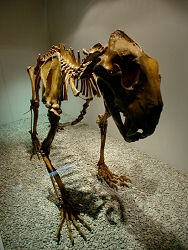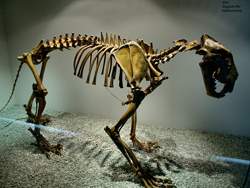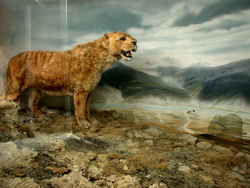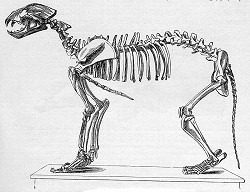Cave Lion
Pantera leo spelaea




The Cave Lion (Pantera leo spelaea) lived about 900,000 to 10,000 BP in Europe. They vanished at the end of the last Ice Age. It seems that they could not survive the climatic changes at the end of the cold period and the disappearance of the vast grassy plains with their many animals. But probably the extinction was caused by humans. Either they were hunted because they were competitors, or they starved to death because humans hunted and exterminated their prey.
Being about 30% larger than their modern African relatives, they reached a shoulder height of 1.5 m. This larger size was useful for hunting some of the larger herbivores of the European tundra, especially bison. It was probably the largest cat that ever lived on earth.
This so-called Cave Lion is said to have lived in natural caves in winter.
This is based on finds of bones in caves in Germany and the Czech Republic during the 19th and early 20th centuries.
The first description was made by the physician and naturalist Georg August Goldfuss on the basis of a skull from the
 Zoolithenhöhle
of Burggaillenreuth near Muggendorf in the Franconian Alb.
Modern scientists doubt that it really used caves, except perhaps for a very short time as a shelter, so the name is not really deserved.
Unlike the cave bear, there is no solid evidence that cave lions spent more time in caves than a casual visit.
Lion bones are often washed up or carried in by hyenas, which used caves regularly but are generally not called "cave hyena".
For this reason it is today also called European Lion
Zoolithenhöhle
of Burggaillenreuth near Muggendorf in the Franconian Alb.
Modern scientists doubt that it really used caves, except perhaps for a very short time as a shelter, so the name is not really deserved.
Unlike the cave bear, there is no solid evidence that cave lions spent more time in caves than a casual visit.
Lion bones are often washed up or carried in by hyenas, which used caves regularly but are generally not called "cave hyena".
For this reason it is today also called European Lion
And there is another problem with the name, the "leo". The name Pantera leo spelaea is the lion (Panthera leo) plus the name of the subspecies spelaea. For a long time it was regarded as a more or less clearly defined subspecies of the lion. Today genetic research shows that it was actually an independent species. As a result the name Pantera spelaea is used in younger publications.
There are several cave paintings of European lions, although they are rather rare, compared to other animals. And there is also a famous ivory figurine showing a lion-headed person. All those depictions show no mane and no tuft at the end of the tail. Although it could be possible that all the paintings are of females, it is rather unlikely that only female animals were drawn. So generally it is assumed, they really did not have a mane or a tuft.
Literature
- A. Argant, J-P. Brugal (2017): The cave lion Panthera (Leo) spelaea and its evolution: Panthera spelaea intermedia nov. subspecies, Acta zoologica cracoviensia 60(2), 60-98. researchgate.net DOI
- R. Barnett, B. Shapiro, I. Barnes, S. Y. W. Ho, J. Burger, N. Yamaguchi, T. F. G. Higham, H. T. Wheeler, W. Rosendahl, A. V. Sher, M. Sotnikova, T. Kuznetsova, G. F. Baryshnikov, L. D. Martin, R. Harington, J. A. Burns, A. Cooper (2009): Phylogeography of lions (Panthera leo ssp.) reveals three distinct taxa and a late Pleistocene reduction in genetic diversity, Molecular Ecology 18, 1668-1677. researchgate.net DOI
- Anthony J. Stuart, Adrian M. Lister (2011): Extinction chronology of the cave lion Panthera spelaea, Quaternary Science Reviews, Volume 30, Issues 17–18, August 2011, Pages 2329-2340. online DOI pdf
- See also
 Search DuckDuckGo for "Cave Lion"
Search DuckDuckGo for "Cave Lion" Panthera spelaea - Wikipedia (visited: 20-OCT-2023)
Panthera spelaea - Wikipedia (visited: 20-OCT-2023) The Cave Lion (visited: 20-OCT-2023)
The Cave Lion (visited: 20-OCT-2023) The Cave Lion (Panthera spelaea) (visited: 20-OCT-2023)
The Cave Lion (Panthera spelaea) (visited: 20-OCT-2023) Neanderthals hunted—and revered—cave lions (visited: 20-OCT-2023)
Neanderthals hunted—and revered—cave lions (visited: 20-OCT-2023) Cave Lion (visited: 20-OCT-2023)
Cave Lion (visited: 20-OCT-2023) Panthera spelaea (European/Eurasian cave lion) (visited: 20-OCT-2023)
Panthera spelaea (European/Eurasian cave lion) (visited: 20-OCT-2023)

 Index
Index Topics
Topics Hierarchical
Hierarchical Countries
Countries Maps
Maps